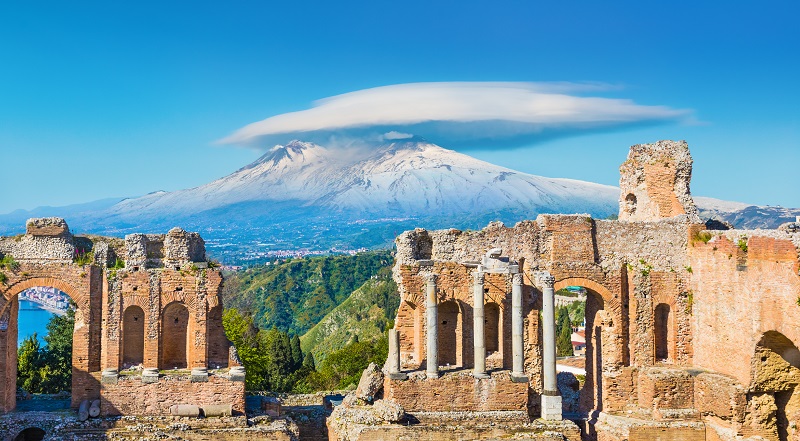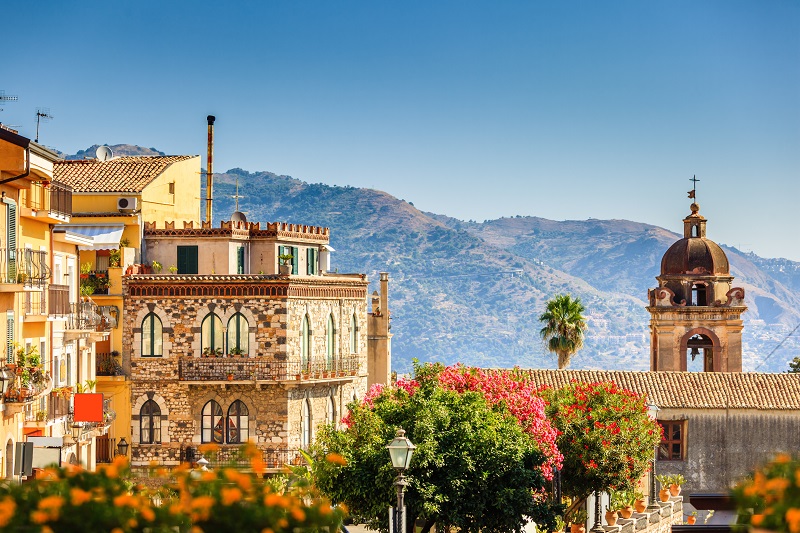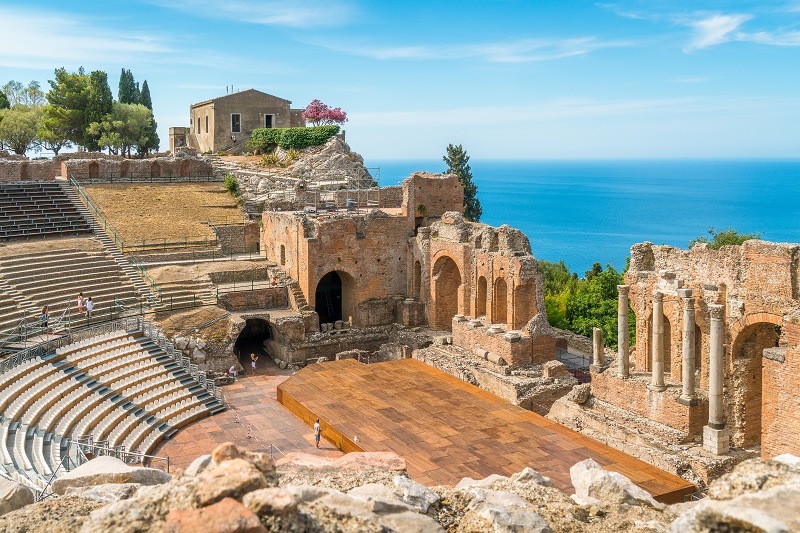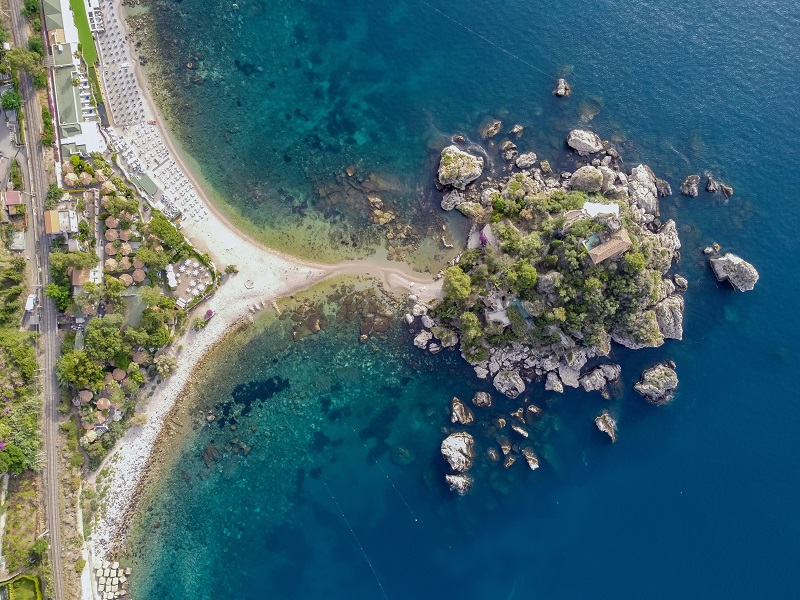Taormina was an unmissable stop of the Grand Tour, the journey of the nineteenth-century European aristocracy. Even today, the city is a popular destination for international tourism, with many tourists arriving each year from all over the world to discover its beauty.
Once you enter Porta Messina, the atmosphere is surreal: it is like living a dream.
Let’s discover the ten best things to see and do in Taormina.
- Corso Umberto
As soon as we cross the stone arch, we can see the sparkling modernity alongside the ancient splendour of the past.
We are on Corso Umberto, the shopping street. It is closed to traffic, and it runs through the whole city. Let’s take a struscio: a slow stroll. In Corso Umberto, there are clothing boutiques, jewellers, craft shops and antique stores. It will be easy to find the perfect souvenir.
We continue to enjoy a walk through the narrow streets, scented alleys, flowers and colourful objects.
- Palazzo Corvaia
The first architecturally interesting structure we see is Corvaja Palace. In the 15th century, the Sicilian Parliament had its seat in this medieval fortress. In its characteristic inner courtyard, we can admire reliefs and arched windows dating back to the Christian era. The style of the palace has Arabic influences. On the first floor, we can visit a museum and art gallery, and on the ground floor, there is a tourist information office.
- Naumachia
Walking down a staircase that crosses Corso Umberto, we discover a hidden treasure. The Naumachia is one of Sicily’s most important Roman monuments and a must-see on a tour of ancient Taormina.
It is an impressive construction. The name comes from the games of historic naval battles that Romans used to play here.
- Piazza XXV Aprile
We continue our walk towards Porta Catania. The gate is at the opposite end of the Corso (about 800 metres away). On the right of Porta Catania, there is a sign saying “Italy’s narrowest alley – 43 cm“. We record our visit with a selfie.
Halfway down, we come to one of the most beautiful historic squares on the island. XXV April Square is a stunning sight. We can stop on its precious chequered floor to enjoy the Babelic chatter of tourists and watch the crowded benches. Many people look out from the magnificently carved stone balcony. The view from here is breathtaking.
We catch our breath and enjoy the landscape. In front of us, we see the Ionian Sea and prickly pears caressed by the sea breeze. The most inspirational time to look at the view is at dusk when the sun sets and the square starts to light up.
- Getting a glimpse of the Churches
Looking around, we notice the historic buildings surrounding the square. Among them is the church of Sant’Agostino, whose particular feature is its crenellated bell tower. Then there is the Baroque church of San Giuseppe. Its beautiful double staircase stands next to the impressive Clock Tower. The gate of the third city wall still exists and was once placed next to the tower.
- Duomo di San Nicolò di Bari
We continue our walk. Struciando (slowly walking), we arrive in the square of the Cathedral of San Nicolò di Bari. The imposing and squared Church silently observes the beautiful and lively Baroque fountain, called “Quattro Fontane“. If opposites attract, together they are a perfect couple.
- Palazzo dei Duchi di Santo Stefano
Porta Catania is the southern entrance to Taormina. Here we can see one of the masterpieces of Sicilian Gothic art: the Santo Stefano Dukes Palace. The building dates back to the 14th-century, and its architecture blends features of Arab and Norman styles.
The Palace stands in the old Jewish quarter and is the former residence of the noble De Spuches family, of Spanish origin. In front of the two main facades, there is a beautiful garden. Today the mansion is the location for exclusive cultural events and wedding celebrations. It is also home to the Mazzullo Foundation, a brilliant sculptor who combined tradition and modernity. Many of his works are on display in the Palace.
- Teatro Antico
So obvious that we were almost at risk of forgetting it. The Theatre of Taormina is the first site of archaeological interest in the Archaeological Park of Naxos and Taormina. It testifies to the taste of the ancient Greeks in choosing scenic places to build their buildings.
From the ancient theatre, you can see Mount Etna and the gulf of Giardini-Naxos: the view is breathtaking. On clear days you can even see the coast of Calabria. The theatre is the town’s main monument, both for its historical and architectural value and the spectacular location. The view from this place is called the panorama par excellence. Absolutely not to be missed, once in Sicily.
Discover more on Taormina Archeologica and Parco Archeologico di Naxos audio tour izi.TRAVEL
- The Villa
Not far from Piazza XXV Aprile, we visit the public garden. It is on the outskirts of Taormina but is one of the most beautiful and surprising places in the town.
The public garden history is related to the life of Lady Florence Trevelyan, a Scottish woman.
The park dates back to the late 19th century. It looks like a typical English garden. It develops on several levels connected by stairs. There are small squares hidden in the lush nature where we can see a botanical garden. The “Victorian Follies” are fabulous constructions in arabesque style: is where the Lady loved to welcome her guests or paint.
In spring or summer sunny days, the leafy trees provide shade and coolness, so the “Villa” is a true paradise. If we sit on a bench, we can admire the postcard view of the Bay of Naxos and Mount Etna. It is a true joy for the soul.
- Isola Bella
Lady Florence definitely had good taste. In 1890 she bought the tiny island of Isola Bella and built a lovely house.
Isola Bella is not a proper island. A narrow strip of pebble beach connects it to the mainland. At high tide, the central part of the beach is underwater. Today the area is managed by the environmental protection centre of the University of Catania.
The beach is made of gravel and very large stones and is the perfect place for sunbathing. Let the calm waters of the Ionian Sea caress us.
To learn more about the history of Isola Bella, we can visit its natural museum.





